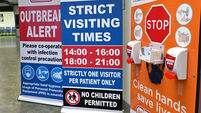Toy show rapped for ‘gender stereotypes’
Researchers who studied the hugely popular pre-Christmas programme — watched by more than 1.3 million viewers — said Mr Kenny’s comments about certain toys helped drive a wedge between boys and girls and served to “undermine the objective of promoting gender equality”.
“The main presenter persistently reinforced stereotypes of gender in his short introductions and comments on the products shown,” the researchers said.
“For instance, when looking at a particular children’s product, in which a human skull is shown to ooze slime, the presenter exclaimed, ‘Made for boys, I think’. This contrasted with his assertion that a dancing ballerina was ‘going to be a big hit for girls’.
The dressing-down for RTÉ’s top-paid presenter comes in a report on gender equality in toy design and marketing commissioned by the Equality Authority and carried out by researchers from the Centre for Gender and Women’s Studies at Trinity College Dublin.
They looked at how toys were made, presented in catalogues, advertised on television and displayed in stores and found rigidly old-fashioned views held sway, with action and adventure toys targeted at boys, while girls were stuck with dolls and kitchen sets.
Blues and pinks were used to differentiate between toys directed at boys and girls, and the language used in slogans and promotions was generally active for boys and passive for girls.
Television adverts followed the same pattern. “For boys there was a cry of ‘Who will win the Battle?’ in advertisements for Lego Exo-force,” the researchers found. “For girls, the voices exclaim ‘She’s so soft and pretty’ for Barbie First Best Friend.”
Bratz dolls came in for criticism for sexualising girls with their “big full lips and revealing clothing”, as did the use of the Playboy logo on stationary and clothing.
Equally, there was criticism of Yorkie chocolate bars for using the “Not for Girls” slogan, and of the David and Goliath T-shirt and novelty company for use of the slogan “Boys are stupid, throw rocks at them”.
Toy store owners were also found to be at fault for segregating toys into boys’ and girls’ aisles.
The Advertising Standards Authority for Ireland code states that sex stereotyping should be avoided but the researchers say this may not be sufficient, pointing out that in Sweden, no advertising aimed at children under 12 is allowed.
Chief executive of the Equality Authority Niall Crowley said the organisation had received complaints from the public about gender issues in children’s products. He said the equality watchdog wanted to help the Advertising Standards Authority to better implement its code and he called on the wider advertising industry to observe it.
“An advertising process is needed that challenges gender stereotypes rather than communicating and reinforcing them.”
A spokesman for the Late Late Toy Show acknowledged that “at times, some of the toys featured have been clearly target-marketed on a segmental basis by their distributors/manufacturers, which can on occasion be referred to in the presentation of the items on-air”, but he said many of the toys were demonstrated by children who had selected the items themselves.
The spokesman said: “The Late Late Toy Show is satisfied that it does not in itself reinforce gender inequality, as suggested, but rather sets out to offer a creative platform for parents and children to explore the world of toys and play via a responsible and entertaining presentation.”
* www.equality.ie












